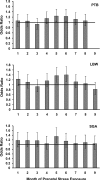Timing of prenatal maternal exposure to severe life events and adverse pregnancy outcomes: a population study of 2.6 million pregnancies
- PMID: 21321257
- PMCID: PMC3070756
- DOI: 10.1097/PSY.0b013e31820a62ce
Timing of prenatal maternal exposure to severe life events and adverse pregnancy outcomes: a population study of 2.6 million pregnancies
Abstract
Objective: To identify the impact of timing of prenatal stress exposure on offspring risk for shortened gestational age, preterm birth (PTB), low birth weight (LBW), and small for gestational age (SGA), using a population-based sample.
Methods: Swedish longitudinal population registries were linked to study all individuals born in Sweden from 1973 to 2004. Prenatal maternal stress exposure was defined as death of the father of the child or first-degree relative of the mother. Using linear and logistic regression, timing of stress exposure was examined across pregnancy, by month, and by novel periods created based on month of stress exposure findings.
Results: A total of 2,618,777 live-born, singleton infants without congenital anomalies were included; 32,286 were exposed to prenatal maternal stress. Examining associations between stress exposure and outcome by the month revealed that risk increases midgestation, particularly after months 5 and 6. Combining months 1 to 4, 5 and 6, and 7 to 9 as potential periods of differing vulnerability, it was found that stress during period 2 (months 5 and 6) was associated with the greatest risk for shortened gestational age (-0.52 days, standard error = 0.15, p = .0006), PTB (odds ratio [OR], 1.24; 99% confidence interval [CI], 1.08-1.42), LBW (OR, 1.38; 99% CI, 1.19-1.61), and SGA (OR, 1.25; 99% CI, 1.05-1.49).
Conclusions: Risk for shortened GA, PTB, LBW, and SGA are greater post stress exposure during the 5th and/or 6th month of pregnancy. It may be beneficial to refine future analyses to these months. Possible mechanisms include alterations in the hypothalamic-pituitary-adrenal axis and associated stress-responsive molecular regulators.
Figures


References
-
- Levitt P. Structural and functional maturation of the developing primate brain. Journal of Pediatrics. 2003;143:S35–S45. - PubMed
-
- Nathanielsz PW. Life in the womb: The origin of health and disease. Promethean Press; New York, NY: 1999.
-
- Resnik R. Intrauterine growth restriction. Obstetrics and Gynecology. 2002;99:490–96. - PubMed
-
- Pulver LS, Guest-Warnick G, Stoddard GJ, Byington CL, Young P. Weight for gestational age affects the mortality of late preterm infants. Pediatrics. 2009;123:1072–77. - PubMed
-
- Mathews TJ, MacDorman MF. Infant mortality statistics from the 2005 period: Linked birth/infant death data set. National vital statistics reports. 2008;57:1–32. - PubMed
Publication types
MeSH terms
Substances
Grants and funding
LinkOut - more resources
Full Text Sources
Medical

